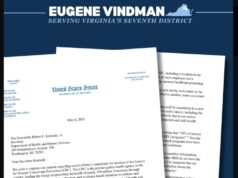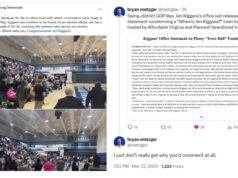by Cindy
{Note: This article refers to the 2021 decennial redistricting that will determine all Congressional and General Assembly districts, not to the recent court-ordered redistricting to fix districts that were drawn unconstitutionally back in 2011.}
Possibly the most important issue before the 2019 General Assembly will be the 2021 redistricting. Since apportioning is a constitutional issue, changing the way districts are drawn requires a constitutional amendment. Constitutional amendments must pass both chambers of the General Assembly twice, and then be voted by the general public on the next November ballot. Since the next opportunity to draw districts will be in 2021 after the decennial Census results are released, an amendment would have to be passed by the 2019 legislature, the 2020 legislature, and be on the November 2020 ballot. (Yes, I know we may have lots on our minds in November 2020, but this is really important too! Every issue that matters to you is affected by whether districts are drawn fairly, whether we have fair representation in the legislatures.)
That means we have ONE CHANCE to make this change–whatever change we want has to pass the General Assembly THIS YEAR to even have a chance. This means that YOU need to make sure you understand how we currently redistrict, and what the possible alternatives are, both so that you can advocate this year and again next year, but also so that you are ready to VOTE on this in 2020. I’m here to help, with a summary and some thoughts. This post will focus on WHO does the redistricting; stay tuned for a second post focusing on HOW the redistricting is done. If you have any questions, leave a comment and I’ll try to answer.
According to the Virginia Constitution, Article II, Secton 6, Congress and the General Assembly “shall be elected from electoral districts established by the General Assembly,” subject to being compact and contiguous and having approximately equal populations. “The General Assembly shall reapportion the Commonwealth into electoral districts…in the year 2011 and every ten years thereafter.” Additionally, the districts must obey the US Voting Rights Act, which prevents districts from being drawn that either “pack” constitutionally-protected minority groups into as few districts as possible, or that “crack” those groups up into as many districts as possible to dilute their voting power.
This means that under the current rules, the legislature draws the lines, subject to veto by the Governor. In more detail, following the release of new decennial Census numbers, the Governor calls a special legislative session to conduct redistricting, and a proportionally-representative bipartisan committee of legislators is formed. That committee consults with experts and seeks public input, before drawing districts. The districts are presented to the full House and Senate for a vote (see, i.e. HB5005 from 2011), and then must be signed by the Governor. Districts are subject to further review by the US Department of Justice, to ensure the Voting Rights Act is not violated.
What does this mean in practice? On the one hand, legislators know their districts well, know the communities, the schools, the geography, and the interests of their constituents, so they do have some advantages in re-drawing districts. But realistically, they also know very well how to use the drawing of districts to protect themselves from ever being voted out of office; or, how to draw districts to make sure their party holds more legislative seats. These objectives don’t necessarily always align–a legislator might favor lines that make his or her own district easier to win even if that comes at the cost of having fewer districts that his or her party can easily win. For the most part though, the party that controls the legislature will draw lines that help them stay in control–and the minority party won’t have the votes to stop them.
If you don’t like the idea of a partisan battle over your representation, and you don’t think legislators should get to draw their own districts, sometimes called “picking their voters, rather than their voters picking them,” then now is the time to think about who you DO want to be responsible for redistricting.
There are many alternatives. Most start with the creation of some sort of redistricting commission. But who should the members of the commission be? Legislators, other government officials, ordinary citizens, scientists,…?
- California’s much-acclaimed recently formed commission consists of 14 ordinary citizens and no legislators. The citizens are five Republicans, five Democrats, and 4 not affiliated with either of those two parties but registered with another party or as decline-to-state.
- Another possibility is a bi-partisan commission with approximately equal representation by political members of each party with one independent tie-breaker member–Delegate Plum regularly proposes something similar to this.
- Or a compromise, such as that regularly proposed by Senator Hanger, Delegate Sullivan, and others, an independent commission with four partisan political appointees plus three “independent” officials–such as the Auditor of Public Accounts, the State Inspector General, and the Executive Director of the Virginia State Bar.
- Other potential compromises might create a commission with a combination of an equal number of bi-partisan political appointees, and ordinary citizen members.
There are lots of alternatives. It’s a good idea for you to think seriously about what you think is the right way to do this–who do you trust to determine our representation? This is a complex issue, and there isn’t necessarily a right answer, so it’s good to think for yourself before you hear what your legislators or any advocacy groups have to say. How strongly do you believe in this being decided by a democratic process versus letting the party in power (which might be the Democrats this time around) control the process?
The other thing we have to take into account, though, is what will pass the General Assembly this year and next? Because if we don’t pass a constitutional amendment this year, or if it doesn’t pass again next year, we keep the status quo, which is legislators drawing the lines in 2021. Several legislators have told me that they don’t think the votes are there to pass a pure citizen’s redistricting commission–this is basically asking legislators to give up their own control of the process, and roll the dice on the outcome. (Rolling the dice may seem like a better or worse outcome, depending on whether you expect your party to be in the majority in 2021.)
Here’s where you come in…start having these conversations with your Delegate and State Senator now. Find out what their ideal is, what they might be willing to go along with, and let them know what you support. Now is the perfect time to be having these conversations, while they’re not in session yet, and still drafting the possible amendment. It would be great if you could also share what you learn with others–in person, on social media, or even here in the comments section–so that we know what the chances are of any particular proposal passing. We need to be smart in our advocacy, and make sure that we’re fighting not just for something that we WANT to pass, but fighting for something that CAN pass. Let’s make our voices heard, and protect our ability to have our voices heard in the future!



 Sign up for the Blue Virginia weekly newsletter
Sign up for the Blue Virginia weekly newsletter







